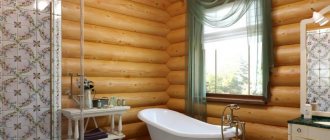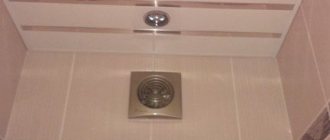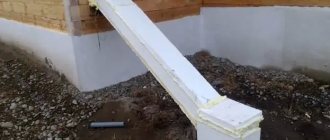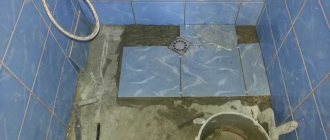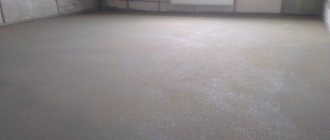Layout of a bathroom in a private house: features
The owner of a private house can choose how many bathrooms he will have, and of what size and purpose; he can provide a window in the bathroom, he can place it in the attic. But this freedom is also limited by common sense and a number of existing norms and rules: everything must be ergonomic, convenient, and safe. Let's focus on the most important points.
How many bathrooms there should be in a house and how to place them depends on the area, number of residents and expected guests.
| A small one-story house with two bedrooms. | Large combined bathroom. Option: a bathroom (a large room with a bathtub) and a restroom (a room with a toilet and sink) or a small bathroom (toilet + shower or shower compartment) closer to the living room. |
| Two-storey house with three bedrooms (or more), inhabited by two adults and children | three bathrooms. On the ground floor there is a small guest bathroom (if the guest bedroom is downstairs, if not, a toilet will suffice); on the second there is a bathroom with access from the parents' bedroom, and a bathroom that the children use (it opens onto the corridor). |
| A house in which three generations of a family live. | For older people, a full bathroom is made next to their bedroom on the first floor; Guests are offered a bathroom next to the living room. |
In a two-story house, the bathroom is placed above the bathroom - this way you can save on communications.
It is forbidden to install a bathroom above a living space.
It is not recommended to place a washing machine in the bathroom; it is better to plan another room for it.
Room layout
It is preferable to arrange bedrooms on the side from which the sun will not wake you up in the morning. However, this is not always possible. But they should always be located away from the hallway and not be accessible. The layout of the rooms in the program should be such that it does not require excessive heating costs. Their ventilation should also not cause any complaints.
Location and layout of the bathroom on the house plan
On the north side, an area of 20 meters is often allocated for the kitchen. However, housewives are interested not only in its size, but also in the daytime illumination. Next to it you should make a convenient storage room, which does not need windows for natural light. The floors of these rooms are usually covered with ceramic tiles, because their maintenance is simple and does not require the use of complex cleaning mechanisms or expensive detergents.
It is better to place the living room or recreation room in the western part. In the first half of the day they are empty, and in the evening the household members like to relax and receive guests in a bright room. Here, if desired, you can install a fireplace, which will add coziness and comfort. Some homeowners do not include it in the project in advance, intending to install it later in an already built house. They don’t realize that doing this later will be much more difficult and expensive.
Various bathroom planning options
The location of the office is planned away from household noise. Windows are installed so that during the daytime no additional lighting is required, and ventilation is natural. If desired, a veranda or terrace can be added to the house. Their sizes do not have to be determined in advance, but a place for them is allocated, as a rule, on the side with more sun and the most beautiful view of the surrounding area. It is desirable that the entrance to these additional extensions be directly from the living room or recreation room.
When the house has two floors, the first floor contains a kitchen with a dining room and a storage room, one bathroom, a boiler room, and a living room. A bedroom for older people must be here, below, and its floor requires heating or at least a wooden covering.
Upstairs: sleeping quarters, recreation room, another toilet and bathroom in a private house. It is advisable to install the staircase leading to the second floor of the house in the corridor, even if it is small. It is important that it is not deprived of daylight. The boiler room is equipped on the north side.
Layout plan for two bathrooms in a two-story cottage
An attic in a one-story house is often not planned, so high strength of the wooden ceiling is necessary so that the possibility of its installation in the future is not excluded. First of all, it must have a reliable floor. It is simply necessary in a one-story house, as it significantly increases the usable living space.
Where to make a bathroom
The placement of a bathroom largely depends on whether it will have a window. If not, then it can be placed near the northern wall of the house. If you want a window, especially a large one, then you need to choose a different location (ideally, the bathroom windows face east).
In a bathroom without a window there must be forced ventilation
A small window is also acceptable in the restroom, but then the window sill must be at least 130 cm from the floor in order to place a toilet or cabinet under it.
Lighting in a bathroom project
The choice of bathroom fixtures must be approached with particular seriousness, since we are talking about safety. An incorrectly selected device may cause a short circuit. To do this, you need to pay attention to the IP indicator, which is set for each model. For wet areas, choose lamps with an IP rating of at least 55. Devices located far from the shower may have an index of 44.
To make your interior design project more comfortable, you should choose multi-level lighting. The overhead light can be made not only central, but each zone can be illuminated separately. For the lower level, take compact sconces, make LED lighting or place accents locally with spotlights.
When illuminating a mirror, you need to remember the function of light in this area. It should fall so as not to create unnecessary shadows on a person’s face and not distort the natural color of the skin. Therefore, neon is not suitable for these purposes.
How to determine the size of a bathroom
Giving too much space at home to the bathroom is as unwise as installing a bathroom in a cramped space. According to current SNIPs, the minimum area of a combined bathroom is 3.8 square meters. m.
But such a micro-premises, reminiscent of cramped bathrooms in Khrushchev-era buildings, does not allow us to talk about any comfort. But the main bathroom in the house should be comfortable and spacious - these are the things that make up your lifestyle. The spacious, comfortable bathroom fully corresponds to the philosophy of country life - we moved out of town, among other things, to take a bath while admiring the large flakes of snow outside the window.
The optimal bathroom area in a private house for a family of 4 people is from 8 sq.m.
Let's see how this figure turned out.
Approximate area required:
- for a shower stall – 2-2.5 sq.m;
- for a sink – 0.9 – 1 sq.m;
- for a toilet 1.2 - 1.8 sq.m.
The experience of FORUMHOUSE participants shows that a bathroom in a private home is never too large.
Roberta
I have a bathroom space of 5.5 sq.m: shower, sink, toilet, drawer for dirty linen, and a wall cabinet. Nothing else will fit unless you push it in. And 15 sq.m. They will sell out with a bang, but maybe not enough!
When planning a bathroom, you need to consider the following parameters:
| Distance from the bath (shower stall) to another piece of plumbing | Not less than 0.7 m, optimally 105 cm. |
| The distance from the sink to another piece of plumbing. | At least 70 cm. |
| Distance between washbasin and toilet. | Not less than 25 cm. |
| Free space in front of the toilet | 70 cm. |
| Free space to the left and right of the longitudinal axis of the toilet | 40 cm. |
| Minimum distance between toilet and bidet | 25 cm. |
| Distance between bathtub (shower) and heated towel rails (hangers) | 50-70 cm. |
| Distance from floor to washbasin. | From 80 cm. |
| Doorway width | Not less than 0.55 m. |
Varieties
So, we want to install a toilet in a country house. This can be done in one of two ways:
Traditional options
The idea is simple: install a toilet in the house and run a pipe from it to a cesspool located 5 m from the house. In order for waste to fall into the pit, it must be washed off with water. Hence the conclusions:
- This option is suitable for houses equipped with running water.
- Due to the large volume of wastewater, instead of a cesspool, which will fill quickly, it is better to use a septic tank.
Traditional country toilet
In the latter case, most of the water can be filtered and made suitable for discharge into the ground.
Innovative solutions
If there is no running water in the house or it is rarely visited, you can install one of the types of dry closet. What is common to such designs is that waste accumulates in a sealed container located directly under the toilet, where it is processed in a certain way.
Modern electric dry closet
As the container is filled, it is emptied, and the waste as a result of processing usually does not have a pronounced unpleasant odor.
Depending on the method of processing feces, dry toilets are divided into the following types:
Composting
There are two subspecies:
- Powder closets. Each time after visiting the toilet, the waste is sprinkled (“powdered”) with a portion of peat, ash or sawdust. This powder, firstly, blocks the spread of an unpleasant odor, and secondly, it prevents the supply of oxygen to feces. In an oxygen-free environment, specific biochemical processes occur, upon completion of which waste is converted into compost, suitable for use as fertilizer.
- Drying dry toilets. A compressor forces air through the waste collection chamber (thrown out through an exhaust pipe connected to it), as a result of which its contents are completely dry. This also causes feces to turn into fertilizer.
The simplest peat dry toilet made from a plywood box and a plastic bucket
Separation
Processing consists of separating solid and liquid fractions, after which the liquid is filtered. Once the storage container is full, the solids are removed for composting.
Thermal
The waste is burned with a powerful electric heater (from 5 kW) to ash. The water evaporates and is removed through the exhaust pipe.
Cryogenic
The opposite solution: the waste is frozen, which leads to the death of microbes and neutralizes the odor.
Many people associate the country toilet with discomfort. However, making a comfortable option is quite simple. Wooden toilet for a summer residence - consider the types of designs and their advantages.
You can see a comparison of different types of country dry toilets here.
Which dry toilet to choose for your dacha and where to buy it? Read the answers to these questions here.
Toilet arrangement
Everything is clear with a dry toilet - you just need to purchase and install it. With a classic type toilet you will have to tinker. The creation process is divided into two stages:
- Selecting a waste collection site.
- Bathroom equipment.
Monolithic concrete cesspool
Wastewater collection point
The simplest option is to build a cesspool. You can go this route if the dacha is visited relatively rarely, otherwise you will have to call a sewer truck too often to remove accumulated waste.
Just digging a hole is not enough - you need to form a sealed container in it to prevent contamination of the soil by runoff.
Here's how the construction works:
- On an area of 2 - 3 sq. m, a pit is dug 2.5 m deep. Please note that it must be located in a lowland, at least 5 m from the house and at least 25 m from the well or well.
- The bottom is covered with 3 layers of plastic film.
- A layer of compacted clay 20 cm thick is laid on top of the film.
- The clay is poured with concrete 10 cm thick.
- The walls can be covered with boards, but such covering will only last for 10 years. A more durable option is to line the pit with ceramic bricks (silicate bricks cannot be used!), which will last for about 20 - 25 years.
- The pit is covered with a concrete slab with a hatch or thick boards on which the cut fertile soil can be laid.
A more labor-intensive, but also more practical solution is to build a septic tank. This is a structure of 2 or 3 chambers, the last of which is a drainage well (instead of a concrete bottom there is a gravel filter), and the rest are sealed. Overflow pipes are installed between the chambers at a certain height.
An example of a plastic septic tank
The idea is as follows: each of the sealed chambers plays the role of a sump: heavy fractions settle down, light fractions float up, and relatively clean water flows through the overflow pipe (it starts with an elbow turned downward) into the next container.
If it is also sealed, the 2nd stage of settling occurs, after which even more clarified water, again through an overflow pipe, enters the 3rd chamber, from which it drains into the ground through a gravel filter. Thus, only the waste itself remains in the sedimentation tanks, which is why they have to be pumped out much less frequently than a cesspool.
The walls of the chambers and the partitions between them can be lined with ceramic bricks; the chambers can also be assembled from concrete rings. If funds allow, you can purchase a modern plastic septic tank, which, at the customer’s request, can be equipped with a disinfection system and other options.
Bathroom equipment
For a bathroom in a house, you need to either allocate an area near the outer wall from the side of the cesspool, or build an extension of the toilet and shower to the country house.
If there is only a toilet here, the area of the room should be at least 1.5 square meters. m. If there is also a washbasin, that is, a combined bathroom, then the allocated area should be at least 3.8 square meters. m.
Toilet in the form of an extension
If you are not yet ready to shell out money for an extension, the room inside the house should be fenced off with partitions. The most affordable option is plasterboard partitions: a frame is built from metal profiles, which is sheathed on both sides with plasterboard sheets. You can put mineral wool into the frame, protecting it with a vapor barrier - due to its soft structure, it retains sound well.
If the owner is ready to spend money on a more solid option, the partition should be made of brick.
Laying brick partitions
The finishing used inside the bathroom must be moisture-resistant and have a smooth surface so that it can be washed. If you are not satisfied with ceramic tiles due to their high cost, you can use a very affordable alternative - plastic panels. They can be fixed directly to the frame; no drywall is needed.
The toilet is installed so that the sewer bed between it and the lowering into the underground has a length of no more than 1 m.
The bottom of the vertical section (dip) should reach the soil freezing depth characteristic of the given region.
Next, a pipe is laid from this point to the cesspool.
If the foundation under the house is strip, it is necessary to drill an opening through which the pipe will come out.
Of course, it is better to provide a toilet at the stage of building a house - then the opening can be easily made during the pouring of the foundation, having first placed a piece of pipe in the formwork.
While a country house is being built, the summer resident needs somewhere to spend the night. Two-room dacha cabins with toilet and shower are an option for a comfortable stay on a personal plot.
You can familiarize yourself with the principle of operation of a biotoilet for a summer residence by reading this material.
The outer part of the pipe is laid in a trench with a slope of 3 cm/m.
A sand cushion is placed under the pipe, and on top it is first covered with a small layer of expanded clay and only then with soil.
Layout of a combined bathroom
If the bathroom area is more than 8 square meters, the bathtub can be placed in the center - the main thing is that it can be approached from all sides, and the recommended distances between different plumbing items are observed.
It’s great if there is a chair in the bathroom; it must be waterproof. The chair can be placed next to the bathroom, but cabinets and chests of drawers can be placed further away to protect them from the harmful effects of moisture.
When planning a bathroom, convenience is at the forefront, this is important even in small things: rugs should not be slippery, heated towel rails should not be narrow. If the room will be used by older people, it is better to install a shower stall with a seat instead of a bathtub and limit yourself to a minimum of furniture to create spacious passages.
Types of finishing of walls, floors and ceilings of a bathroom in a country house
You can give the room a complete look with the help of finishing. It is first necessary to hide all communications - hide the cables in special boxes, and fill the pipes in the floor with a movable cement-sand screed. A layer of waterproofing should be laid on top of the screed, and then you can begin laying the flooring and covering the walls and ceiling.
To decorate a bathroom in a wooden house, you can use various materials. So for wall cladding it is used:
- drywall;
- tile;
- wooden lining;
- PVC panels.
Attention: to ensure that the finish does not suffer from moisture, high-quality ventilation should first be carried out, and all surfaces should be treated with antiseptic and protective preparations for thorough waterproofing.
A beautiful and spacious bathroom in a country house, decorated with wooden lining.
To decorate the bathroom ceiling, you can use the same materials as for the walls. Various decorative effects can be achieved by using suspended and tensioned structures.
Methods for decorating the ceiling when arranging a bathroom in a wooden house
Bathroom floor finishing can be made from the following materials:
- ceramic tiles (preferably with anti-slip coating);
- linoleum;
- wood (terrace board);
- waterproof laminate.
Advice: when laying a floor with wood or laminate, it is better to lay tiles in places of greatest contact with water.
A high-quality floor sets the mood for the entire room
How to determine the size of a guest bathroom
The size of the guest bathroom is determined depending on how often guests come to the house and how many of them there will be. But usually architects recommend making guest bathrooms in private houses. It is also recommended to think about who will use the bathroom - if only guests, then a minimum set of plumbing fixtures will be sufficient in this room (toilet, sink, heated towel rail; perhaps a shower stall or a compartment with a partition). If the owners also use this room, then you can make a full-fledged combined bathroom with bathtub.
When planning a guest bathroom, you need to remember that:
- Forced ventilation is required in this room.
- it is better to do it either in the hall and corridor, immediately near the entrance, or next to the rooms in which guests will stay.
Equipment and design
So, the location of the bathroom in a private house and its dimensions have been chosen. Now let's look at how to make the restroom comfortable by arranging the plumbing fixtures correctly. The layout of the devices must be done so that:
- they were convenient to use,
- The owners did not have any problems maintaining the sewerage system.
Bathroom in a private house. Photo of a comfortable ergonomic room
Placement of plumbing fixtures
Plumbing fixtures are installed in accordance with SNiP standards.
The minimum permissible free space in front of a bathtub or shower is 70 cm, in front of the toilet - 60 cm. The distance between devices should not be less than 25cm. The minimum height of the sink is 80cm from the floor.
Plumbing fixtures should be positioned so that they are convenient to use.
The toilet is placed in close proximity to the riser - after the bath and sink. The farther it is from the main pipe, the higher the risk of blockages.
Furniture installation
In a small bathroom in a country house or in a one-story village house, only shelves are usually installed.
Photo of a bathroom in a wooden house. Convenient shelves for storing household chemicals
The large restroom in the cottage can accommodate an entire set. A cabinet for storing shampoos and gels is usually located next to the bathroom. Bedside tables with drawers for cosmetics, towels and small household appliances (hair dryer, razor) - not far from the mirror and sink.
Comfortable cabinets and bedside tables for a large bathroom
Restroom design project
The bathroom should be decorated in the same style.
Typically, the design of this room follows the interior style of the building itself. However, there are exceptions. The nautical style, for example, is suitable for almost any restroom. Toilets located in attics are often designed in a loft style.
Original bathroom in a loft country house
Unlike restrooms in city apartments, bathrooms in private houses are usually equipped with a window. Such a room should be decorated with indoor plants.
Bathroom in the country. Photo of a mini restroom with indoor plants
It is better to close the window itself not with curtains, but with hygienic blinds. A mandatory attribute of any bathroom is a mirror. It can be decorated with a beautiful frame that matches the style of the interior and plumbing.
A mirror can become a real “highlight” of a bathroom
The lining for the floor, ceiling and walls of the restroom of a country house should:
- be moisture resistant
- do not be afraid of temperature changes (for dachas),
- be easy to clean and hygienic.
All these requirements are met by materials such as tiles and PVC panels.
Most often, restrooms in country houses are finished with tiles and PVC panels
Ceramic tile
Durable and beautiful tiles - the perfect finish for a restroom. You can tile the entire bathroom or combine it with other materials.
Bathroom in the country. Photo of a room partially tiled
Instead of tiles, you can use ceramic or smalt mosaics to decorate the restroom. This material has recently become very popular. The only drawback of tiles and mosaics is that they are somewhat difficult to install.
Neat restroom in a minimalist style, decorated with mosaics
Panels
PVC panels are distinguished from tiles by their not too high cost. They are easier to install, but less resistant to mechanical damage. Choosing panels of a suitable shade will not be difficult for a restroom in any style.
Wood-look plastic is a very good finishing option for a country house restroom
Other materials
Sometimes materials such as plasterboard, lining and plywood are used to cover the walls of a restroom in a country house. The first option is more suitable for a brick or concrete building. Plywood and clapboard are often used to line a bathroom in a wooden house.
Green moisture-resistant plasterboards are used to decorate bathrooms.
As in a city apartment, in the bathroom of a country house you can use suspended, plasterboard and slatted ceilings.
Combined suspended ceiling in the restroom of the house
These are the basic rules for designing and decorating a restroom in the house. Follow the recommendations of experts, be guided by your own ideas about convenience and beauty, and you will get a functional, practical and aesthetic bathroom in a country house.
Layout of a small bathroom
There are simple tricks that can save space in a small bathroom:
- you need to install a wall-hung toilet in it;
- install a small corner sink;
- Light and glossy finishing materials, niches, lighting, etc. will visually expand the space of the room.
Any small bathroom will look more spacious if you lay the same tiles on the floor and walls of the part where the shower is located.
There are also a number of norms and rules that you need to know when planning bathrooms.
- Doors from any bathroom can only open outwards.
- The entrance to the restroom should be made only from the corridor or hallway (in no case from the living room or kitchen).
- The ceiling height in the room into which the toilet door opens should not be less than 2.1 m.
- If the bathroom is in the attic, then there should be at least 1.05 m from the sloping roof to the toilet lid.
Combined or separate bathroom
The choice in favor of one or another layout must be made based on two factors.
- Family composition.
If more than two people live in the house, and there is only one bathroom, you should think about a separate layout option. Often the weekday begins for all family members at the same time, and it is very inconvenient to wait until the bathroom is free. If the apartment has two or three bathrooms, then a combined project can be developed for all or part of them. - Room area.
Small apartments require saving space. By combining a bathroom, you can increase the size of the room, remove an extra wall and door, and save on construction and finishing materials during renovations.
Bathroom layout: what's what
Often, homeowners begin to plan the placement of plumbing fixtures in the bathroom after the house with all the plumbing facilities has already been built, and serious problems begin: “the stone flower does not grow together.”
Here is an example from our participant with the nickname Mishelka1973: she needs to install a bathtub, sink and toilet in her bathroom. The sewer outlet is marked on the diagram with a blue dot.
If you move the sink, a regular 170 cm long bathtub will fit, but the best solution would be a small asymmetrical bathtub.
A corner bathtub is preferable for small bathrooms; it provides incredible space compared to a traditional 170*70 cm bathtub.
The photo below shows a simple corner bath measuring 135x135 cm from a member of our portal with the nickname Starajamisch66.
Starajamisch66 Member of FORUMHOUSE
If you are not two meters tall, do not think that you will not fit.
Here are two more photos of this bathtub from different angles. Hatches in the podium provide access to communications and various useful items stored in it.
According to the experience of our participants, it is better not to buy a side panel for the bathtub, but to tile the box.
When planning your own bathroom, it is recommended to proceed in the following order:
- Draw up a diagram of the premises, indicating the water supply outlet and sewerage drain;
- Make a list of necessary plumbing fixtures and furniture (in descending order of importance). Calculate their sizes.
- “Arrange” objects on the diagram. Ask your FORUMHOUSE colleagues to criticize your project.
How to design lighting in the bathroom?
Bathroom lighting should be selected in accordance with the style and size of the bathroom.
For interiors with a traditional design and warm colors, it is better to choose lighting with a warm tint. For modern interiors and cool-colored walls, it is recommended to choose cool-colored lighting. Keep in mind that cool-toned lighting is best for facials and shaving.
If you plan to install lighting above the mirror, it is recommended to use two lamps located symmetrically on both sides of the mirror, or longitudinal sconces located across the entire width of the mirror. Here you can install either traditional halogen light bulbs or recently fashionable LED lamps and strips.
You can install light in the bathroom as you please: you can put lampshades or recessed lamps in the suspended ceiling or use reflectors.
When choosing lighting for the bathroom, be sure to make sure that it is reliably protected from moisture and dust. There are so-called material protection standards with IP marking, it is indicated on the packaging of each product.
Which toilet is better to choose for the bathroom?
Classic white toilets will look good in any interior style and bathrooms of any size. For bathrooms in a modern style, it is recommended to install a wall-hung toilet. Despite the fact that such a solution will cost more, a wall-hung toilet will make the look of your bathroom even more impressive and unusual, and will certainly delight your guests.
Which is better: a toilet with a classic or hidden cistern?
In recent years, it has become fashionable to hide toilet flush tanks in the wall, when in fact the only visible element of this mechanism is the flush button located on the wall. Such solutions are more expensive than classic flush tanks, but will definitely look better with modern interior styles.
Meanwhile, hidden cisterns can be mechanical or pneumatic. What are their differences? Mechanical frames create more noise, but due to simple flushing technology they are much cheaper. Pneumatic drain systems use compressed air, which is supplied to them when a button is pressed. They are much quieter, but they are more expensive, and their repair can cost a lot of money.
Whatever solution you choose, it is recommended to give preference only to reliable and trusted manufacturers of such systems, such as Geberit and Grohe. Moreover, they produce not only hidden mechanisms for toilets, but also for other types of plumbing fixtures: washbasins, urinals and bidets.
Which bidet is better to choose for the bathroom?
This type of plumbing fixtures can also be standing or hanging. Considering that the color and material of ceramics is different for all manufacturers, it is recommended to choose a bidet from the same company and the same design as the toilet.
Which washbasin (sink) is better to choose for the bathroom?
It is recommended to select a washbasin based on the design of the room. You can install a traditional freestanding pedestal sink, you can install a wall-hung sink, or you can purchase a set of cabinets with a sink (standing or wall-hung).
For small bathrooms, sinks with built-in cabinets are best. Wall-hung or free-standing washbasins are ideal for bathrooms where saving space is not so important to us.
If you have a large family, an interesting idea might be to install a double-length washbasin, rectangular sinks with two chambers and two radiator holes. For wall-hung sinks, you can buy a pedestal or half-pedestal separately, which will hide the siphon and unsightly pipes.
In recent years, sinks with recessed (hidden) faucets have become increasingly popular - from classic faucets to more modern ones. You can choose faucets that are placed on the sink, designed to be recessed into the wall, or built into the wall.
However, when choosing a faucet, remember that it should not only be beautiful, but also functional. If the tap is too short or too close to the sink, it will be difficult to use.
Also keep in mind that ceramics from different manufacturers differ slightly in shade. Therefore, when choosing a washbasin from a certain manufacturer (for example, from Roca), it is recommended to choose pedestals and cabinets from the same company.


